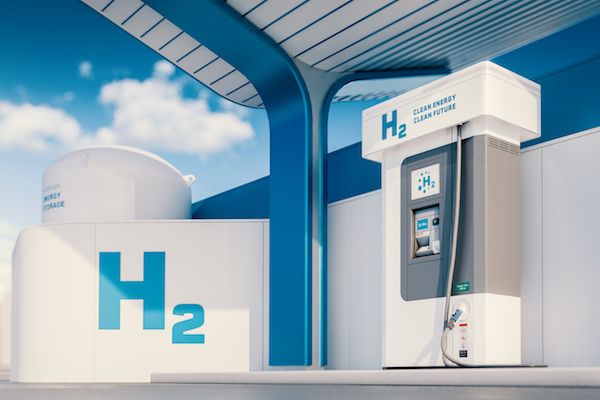The "14th Five -Year Plan" over 50 -seater hydrogenation stations will be completed, and the planning of hydrogen energy infrastructure in Guangzhou!
Author:Huaxia Times Time:2022.09.23

China Times (chinatimes.net.cn) reporter Ge Aifeng, a reporter from Hu Mengran, Shenzhen report
With policy support, the development of hydrogen energy industry has accelerated. As the hydrogen energy industry highland in the Greater Bay Area, Guangzhou strives to create a complete industrial chain of hydrogen energy in the window period.
On September 21, the Guangzhou Development and Reform Commission officially issued the "Guangzhou Hydrogen Energy Infrastructure Development Plan (2021-2030)" (hereinafter referred to as the "Plan"), which pointed out that the "14th Five-Year Plan" stage (2021-2025) planning planning The goal is: 1 new hydrogen -making station, with a total of more than 3 hydrogen -making stations; more than 50 hydrogen refueling stations have been built. Formed 35,000 kg/day (13,000 tons/year) fuel cell hydrogen -made hydrogen -making capacity, forming no less than 40,000 kg/day hydrogenation capacity (15,000 tons/year), can meet more than 6,000 hydrogen fuel cell vehicles for more than 6,000 vehicles Hydrogen demand is running.
From 2026 to 2030, more than 50 new hydrogen refueling stations are planned, and more than 100 hydrogen refueling stations have been established to form a layout of more than 5-seater hydrogen-making and hydrogen-to-hydrogen-to-build stations. The capacity of 100,000 kg/day (36,000 tons/year) fuel cells is used for hydrogen to make hydrogen, forming a hydrogenation capacity of 100,000 kg/day (36,000 tons/year), which can meet the commercial operating needs of hydrogen fuel cell vehicles.
Zhang Shiyuan, the founder of Green Index Technology, said in an interview with the Huaxia Times reporter that the introduction of the "Planning" shows that Guangzhou's continued promotion of the development of the hydrogen energy industry and deepening hydrogen energy in traffic scenarios. "Planning" is based on the provincial and municipal hydrogen energy industry planning documents, focusing on the "infrastructure" industry pain points, and the specific action plan proposed within the scope of Guangzhou. Good benefits, it also helps to attract downstream industrial chain companies to lay out in Guangzhou.
Yan Lei, chief analyst of the Qingqi Group Environmental Think Tank, also pointed out to the reporter of the Huaxia Times that the "Planning" introduced in Guangzhou this time is mainly aimed at the landing of hydrogen making plants and hydrogen refueling stations. It is the first domestic in China about the front end of the hydrogen energy industry chain and middle and middle. The detailed planning of the end part, most of the space in the "Planning" is to promote division of labor at the site selection and landing of hydrogen refueling stations, and conduct a detailed planning preset for the safe use of hydrogen refueling stations. The purpose of doing this "Planning" is to promote the popularization of hydrogen energy at the end as soon as possible. Without hydrogen refueling stations, the main application scenarios of hydrogen energy -traffic applications are talked about soldiers on paper. The promulgation of this "Planning" will definitely further enhance the enthusiasm of public and social capital in the green industry, especially the hydrogen energy zero -carbon industry, and accelerate the pace of Guangzhou to build a hub cities in South China ’s hydrogen energy center.
Implement "one core, one hub, three bases" industrial layout
The "Planning" proposes to implement the layout of the hydrogen energy industry of "one core, one hub, and three bases" in Guangzhou, that is, the key construction of the core area of Huangpu hydrogen energy industry innovation, Nansha hydrogen energy industry hub, Panyu passenger car manufacturing and distribution Power generation research and development base, Conghua commercial vehicle production base and Baiyun and vehicle production base. Furthermore, Baiyun, Huangpu, Huadu, Panyu, Nansha, Conghua, Zengcheng and other districts, combined with the actual situation of the remaining districts, carry out the layout of hydrogen energy infrastructure.
The "Planning" pointed out that 52 plans to build hydrogen energy infrastructure in Baiyun District: 51 hydrogen refueling stations, and 1 hydrogen and hydrogen -made construction station (implemented according to the development of the hydrogen energy industry). Huangpu District planned and constructed 47 hydrogen energy infrastructure: 3 hydrogen -making stations, of which 2 were built in hydrogen -making stations; 5 hydrogen -making and mounting stations were built, one of which had been built; The seat has been completed.
After the plan is implemented, Guangzhou will build three major hydrogen supply centers in the north, middle and south to consider the best hydrogen supply distance at 60 kilometers, which can ensure that the entire Guangzhou city is basically covered, and then effectively reduce the cost of hydrogen transportation. Guangzhou has basically formed a relatively comprehensive hydrogen refueling network, covering the main trunk line in Guangzhou.
At the same time, there are hydrogen refueling stations on Guangzhou-Dongguan-Shenzhen, Guangzhou-Foshan-Yangjiang, Guangzhou-Zhongshan-Zhuhai highway, and the hydrogen refueling point on the main line of the main line in Guangzhou to form a hydrogen energy corridor.
Yan Lei pointed out that the application of hydrogen energy in Guangzhou has a better foundation and has a good industrial heritage. There are chemical enterprises such as Guangxi Petrochemical, Guangsteel Gas, Linde, including Nansha's heavy industrial chain, and have a wealth of hydrogen -energy by -products. It is rich in the nearest supply of hydrogen energy, and the use of scenarios has a solid foundation.
"The" Plan "is a considerable part of the location of the location, which is a large bus station in various large bus stations in Guangzhou. This is also a unique advantage of Guangzhou. Guangzhou's bus system originally paid more attention to the construction of the stations. The area is large and there are many free land. This is a very good prerequisite for promoting hydrogen energy in traffic scenarios, especially the landing and use of bus scenes. "Yan Lei said.
On the eve of the commercialization process
In addition to the target of the number of hydrogen stations, hydrogenation stations, and hydrogen storage stations, the "Plan" also pointed out that by 2022, the proportion of fuel cell vehicles in the field of sanitation and replacement of vehicles will not account The demonstration operation of fuel cell vehicles such as engineering services, warehousing, ports, and ports is not less than 3,000; fuel cell passenger vehicles have demonstrated a hundred vehicles in the fields of official vehicles, taxis, and shared leasing.
By 2025, the proportion of fuel cell vehicles in the field of bus and sanitation is not less than 30%, and fuel cell passenger cars will achieve the commercialization and application of thousands of -level scale. Ceremony battery vehicles have realized commercialization in the fields of logistics, warehousing, ports and other fields. Hydrogen energy and fuel cells realize small -scale applications in the fields of power, thermal power, and realize demonstration applications in rail transit, ships, and aviation. By 2030, the amount of installed capacity of the fuel cell power system in the fields of automobiles, rail transit, ships, aviation and other fields has accumulated more than 100,000 units. At present, because the price of hydrogen fuel cell vehicles is higher than that of fuel vehicles, and the hydrogen energy infrastructure network such as hydrogen refueling stations has not yet formed, the promotion and application of hydrogen fuel cell vehicles is difficult, and the total amount of hydrogen fuel vehicles in the market is not large. According to the China Automobile Industry Association data, as of 2021, the amount of hydrogen fuel cell vehicles in my country was 8,922 vehicles, with a number of not 10,000.
Locke Capital partner Li Yinlin told the reporter of Huaxia Times that the commercial bottleneck of hydrogen fuel cell vehicles is also a difficult point for technological breakthroughs, and it is the storage and transportation of hydrogen energy. The volume energy density of the hydrogen unit is low. Generally, the civilized commercialization scenes need to be used for high -pressure gasized storage and transportation. The pressure on the container is high. It is necessary to continuously develop new materials to ensure that the strength is reduced to reduce costs. Under the existing storage and transportation technology, if the transportation distance is within 50km, the transportation cost of hydrogen is about 5 yuan per kilogram, but when the distance is more than 200km, the transportation cost exceeds 10 yuan per kilogram, and the economic benefits will be reduced rapidly.
"If you want to significantly reduce the cost of hydrogen transportation, you need to build a transportation channel similar to natural gas pipelines. Basic investment is huge. Facing the current small hydrogen energy market, the return on investment is very low." Li Yinlin said, "At present Many enterprises engaged in the research and development of hydrogen energy storage and transportation equipment are the focus of the research focus to improve the structure and material strength of the hydrogen storage container, but it cannot reach the low cost of pipeline transportation; and the infrastructure investment of pipeline transportation requires a large scale of hydrogen energy. The market molding is the difficulty of the industrial chain. "
Dong Xinrui, the founder of Sorghum Capital, pointed out to the China Times reporter that there are not enough hydrogen users to form a certain scale. The barriers of hydrogen fuel cells are controlled by the safety of hydrogen storage and transportation, the degree of localization and cost control of the core components and materials of the electric heap. Key technologies are membrane electrons, bipolar boards, air compressors, and circulating pumps, especially the platinum load, proton exchange membrane, and gas diffusion layer of the catalyst in the membrane electrode.
Zhang Shiyuan said that the hydrogen fuel cell vehicle is still on the eve of the commercialization process. The reason is that the current transportation solution with hydrogen as the raw material is higher than the fuel vehicle in the overall cost of hydrogen, storage and transportation, and injection. At the same time, domestic fuel cell technology is still rapidly iterating. Economics needs to be verified. Therefore, application tests need to be carried out in a broader application scenario to upgrade the iterative iteration of technology, and provide sufficient cases and data from large mass production as soon as possible.
Therefore, Zhang Shiyuan emphasized: "Guangzhou vigorously strengthening the construction of hydrogen energy infrastructure is also to make up for the current deficiencies in China. The technical links such as hydrogen -making, storage, transportation, and injection of hydrogen production facilities in hydrogen energy infrastructure also need to be in a certain volume. The application of the hydrogen energy infrastructure network is expected to further optimize the cost through scale and improve the economy. "
Editor -in -chief: Xu Yunqian Editor: Gong Peijia
- END -
Reporter visits the front line of resistance -Zada County: Be careful and end to grasp the prevention and control of the epidemic.

[Cai Zhi Toutiao] In the second half of the rate hike, the United States declined?

On July 27th local time, the Federal Reserve Commission announced that the federal...